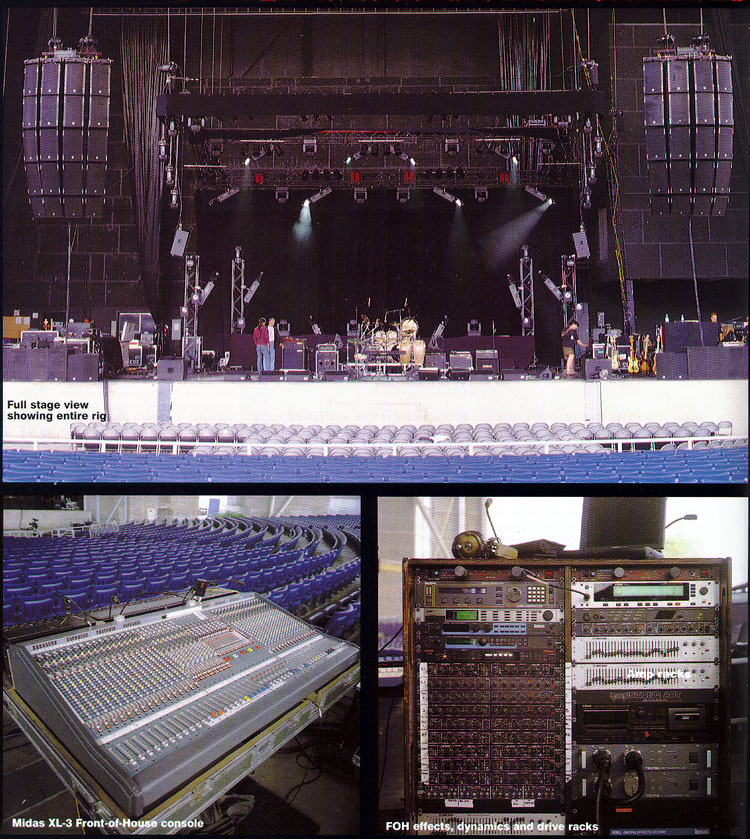 |
||||||||||||||||||||||||||||||||||||||||||||||||||||||||||||||||
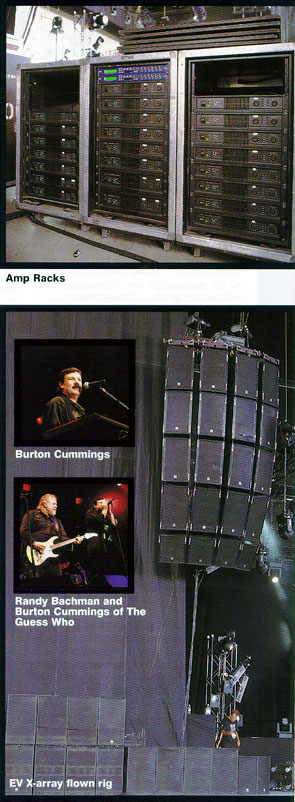 |
||||||||||||||||||||||||||||||||||||||||||||||||||||||||||||||||
| Running
Back Through Canada Tour |
||||||||||||||||||||||||||||||||||||||||||||||||||||||||||||||||
| by Ted Barker
The Venue The Molson Amphitheatre in Toronto on Thursday, June 15, 2000. If you are not already familiar, the Amphitheatre is an outdoor venue with covered seating for 9,000 and some general admission uncovered seating on the lawns at the back of the venue that can add another 7,000. The Amphitheatre is situated on the Ontario Place site and brings in top performers from all over the globe with a program that runs from spring to fall. The venue has several unflattering nicknames coined by people in our industry like "the shed" and "the bunker" because of the acoustic characteristics created by its |
||||||||||||||||||||||||||||||||||||||||||||||||||||||||||||||||
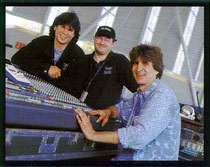 |
||||||||||||||||||||||||||||||||||||||||||||||||||||||||||||||||
|
Left to right: Korey Sherwin, Dave Alderdice and Mick Schmidtmeyer |
||||||||||||||||||||||||||||||||||||||||||||||||||||||||||||||||
| concrete and steel construction. A few efforts have been made to control reflections by using a small number of absorptive panels in the overhead steel structure although they have accomplished little. This venue has a reputation for separating the men from the boys in the sound reinforcement business very quickly. In fact, of the dozen or so concerts that I have seen at the Amphitheatre, only the Supertramp and Steve Miller shows a few years back struck me as having got it right. In fairness to everyone else though, most of the shows are one-nighters and often there just isn't enough time or system control to manage this difficult venue. My suspicion is that the overhead panel plan was abandoned as a greater quantity would hinder the smaller systems trying to get sound to the back of the venue. The management of the Molson Amphitheatre could upholster the seats in an effort to get some floor level acoustic damping thereby making the acoustic condition a little closer in sound check to what it will be when the audience files in. (But that's only my opinion - on a subject that everyone in the pro sound biz seems to have an opinion on.) The other somewhat unusual feature of the venue is that the deck (stage) height is around seven feet high and as such barricades are not required.After talking my way past at least three different security people, I was able to gain access to the loading area backstage. I met up with Sean Hovington whom I have known for several years and who works as the Head of Audio in the Amphitheatre for NASCO -- the production labour supplier to the House of Blues/Molson Amphitheatre. After acquiring the necessary passes, I entered the back stage area to find that load in and set-up had taken place under gray skies. There were severe enough winds off Lake Ontario to warrant swapping out the large video screens for smaller ones that would be less likely to sail away during the show. The flown EV X-array rig was swaying in the breeze, but not significantly enough to worry about, and line check was in progress. Walking through the venue during line check revealed that the X-array rig configuration that Sound Art out of Winnipeg had chosen for this tour adequately covered all sections of seating under the roof. As I made my way to Front of House the crew were in the process of tying in the house delay system that consists of eight EAW KF-850s flown off the roof to cover the general admission areas at the back. The KF-850s are powered by Crest CA series amplifiers fed by EAW crossovers and a Yamaha D1030 delay line processor. |
||||||||||||||||||||||||||||||||||||||||||||||||||||||||||||||||
|
Deck Stack (per side): • 8 EV model 2181 twin 18" sub boxes • 4 EV X-array model Xn front fill boxes supply 60 x 40 degree coverage with one 18", one 12" and a 2" horn. • 2 EV model Xi1152 centre fill boxes with one 15" and a 2" horn. Also used on the tour but omitted due to the deck height on this show are Altec Lansing DTS99 low profile centre fill boxes. The entire rig is powered by QSC Powerlight series amplifiers making better than 100,000 watts of power. Front of House Console: Midas XL3 featuring 32 mono inputs with 8 stereo inputs. Microphone Input List: 1 - Kick stage right #1 Shure SM 91 |
15 - V-Drum left DI Effects, Dynamics and Drive: 1 Eventide H3000 Ultra-Harmonizer Dave Alderdice Head System Tech/Crew Chief, Sound Art (Tour) PS: How did you get to work on the Guess Who tour? Dave: I had worked on tours with Paul Brandt and Edwin this spring and based on referrals from that work, Dave Cousins, Sound Art's owner, gave me a call. PS: How many people on the crew? Dave: Three stage crew, myself and Shawn McLean. PS: What are your most pressing concerns on the tour? Dave: Dealing with venue issues. The boxes (flown array) change configuration in the arena shows because of the audience sitting on both PS: What type of trucking does the tour require? Dave: We have two 53' half drop (trailers)... one for wardrobe, back line and PA and the second for lighting and video. The pack is fairly tight. |
|||||||||||||||||||||||||||||||||||||||||||||||||||||||||||||||
|
Korey Sherwin
System Designer, Sound Art (Winnipeg) PS: How difficult was it for Sound Art to put this rig together? Korey: It was really quite easy. They knew what they wanted and we just gave them whatever they asked for. PS: What were the primary elements to the design of the rig? Korey: Use of the XTA system offered complete control over the array whether the boxes are long throw, medium throw or short throw fill - whatever the application. The sound reinforcement system used at the Molson Amphitheatre consisted of: Flown Array (per side): • 6 EV X-array model Xf long throw boxes supply 40 x 20 degree coverage with two 12" and two 2" horns. • 6 EV X-array model Xb twin 18" sub boxes. • 4 EV X-array model Xn medium throw boxes supply 60 x 40 degree coverage with one 18", one 12" and a 2" horn. • 2 EV X-array model Xcn down fill boxes supply 60 x 40-degree coverage with a 12" and a 2" horn. • 2 EV X-array model Xcb down fill single 18" sub boxes. The rig is flown on EVs XRSL flyware and lifted with Lodestar 2-tonne motors controlled by a proprietary 6 motor controller. House delay, owned by Molson Amphitheatre |
||||||||||||||||||||||||||||||||||||||||||||||||||||||||||||||||
 |
||||||||||||||||||||||||||||||||||||||||||||||||||||||||||||||||
|
Shawn McLean
Monitor Technician, Sound Art (Tour) PS: How smoothly is the tour going from your point of view? Shawn: We're up in four hours and down in two so it has been good so far. PS: How many monitors and mixes does the band require? Shawn: There are 11 mixes on 14 JSI J17s and four Clair Bros. 12AMs plus side wash. PS: I notice that the side wash is flown, what is the reason and what is the trim height and rake? Shawn: The side wash is for Burton in the centre, and to get it over Randy's head the boxes are flown 10' up with a 10-degree down angle. PS: Did the band have any special needs? Shawn: Burton requested the Clair 12AMs and Gary Peterson needed wireless in-ear monitors when he moves to percussion in the "coffee house" set. The stage monitor equipment used on the Guess Who tour consists of: 1 Midas XL250 48-channel console Mick Schmidtmeyer Front of House Engineer, Tour PS: How did you get involved with the Guess Who reunion tour? Mick: I have been working with Burton and Randy for years and after the Pan Am games, it was inevitable that this tour would happen because they had so much fun. PS: What gear did you ask for? Mick: The system was pretty much all together but I requested a Midas XL3 because nothing sounds like that board and it's rock solid. PS: I did not see a sound check on the itinerary, just a line check. Are you mixing on the fly and if so what is the reason? Mick: We don't do a sound check and that way they (the band) can enjoy their days. This is sort of like being on vacation for them. PS: Any problems with the first nine shows or with this one? Mick: The rig goes up and down really slick -- Dave is really good. The fly points (at the Molson Amphitheatre) allow the array to be heard on stage -- they should have been farther forward. PS: What other things are in the future for you? Mick: There is the possibility of some European dates with Burton after the tour. |
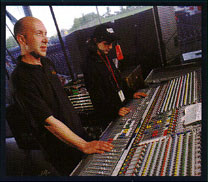 |
Sam Boyd Tour Production Manager
PS: What were the criteria in choosing the sound company for a tour of this magnitude? Sam: Sound Art did the Jewel tour. You check with everyone else who has been doing this for a long time and use the company that everyone seems to be using. |
||||||||||||||||||||||||||||||||||||||||||||||||||||||||||||||
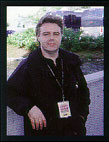 |
||||||||||||||||||||||||||||||||||||||||||||||||||||||||||||||||
|
Sam Boyd. Production Manager |
||||||||||||||||||||||||||||||||||||||||||||||||||||||||||||||||
|
Shawn McLean (at left) and Mike Primeau Monitor land had a special feel at the Amphitheatre with a Lava Lamp perched atop of the Midas XL250 and a white gaff tape rendering of a chalk outline of a body on the stage behind the monitor console. Perhaps this was to serve warning to back stage personnel and guests to stay back but as I arrived they were using red gaff tape in a pattern that resembled splattered blood from the victim. I recommended going for more of a puddle of blood look and they agreed. Everyone associated with this tour seemed to be enjoying themselves once the work was done. Mike Primeau Band Monitor Engineer, Tour PS: What have you been doing lately and how did you get involved with the Guess Who tour? Mike: I toured recently with the Tea Party as their Road Manager and Monitor Engineer and got a call from Sam Boyd about this. PS: Is there anything special about doing monitors for the Guess Who that you would like to mention? Mike: They are all great singers and other than that you just have to keep your eyes on the players. PS: How has it been working with Sound Art? Mike: Shawn is the man! PS: How long are you out for, including rehearsal, pre-production and the tour? Mike: There was a month of rehearsals, a week of pre-production and six weeks on the road. |
||||||||||||||||||||||||||||||||||||||||||||||||||||||||||||||||
|
PS: What are your chief concerns show to show?
Sam: Some smaller venues were just not meant to fly rigs of this kind. Sight lines, side stage seating and a full warm sound throughout rather than just blasting sound to the back are real issues. PS: How did you choose your Front of House engineer? Sam: Mick and I have been working together over the past 10 or 12 years on Burton, John McDermott, the Romantics and Teenage Head. He [Mick] is the one constant. He isn't the fastest but the sound is consistent whether we are in a nightclub, a theatre or an arena. PS: What is your impression of the audio rig to this point in the tour? Sam: Really good. Tonight is the biggest test so far. The Canwest Global Park in Winnipeg will be the biggest test on the tour. The Show The skies cleared and the wind subsided. The near capacity crowd filled all but the smallest patches of grass at the back under a full moon. Ronnie Hawkins introduced Wide Mouth Mason who played a short set that consisted of many of their best-known hits. Wide Mouth had their own FOH console, rack, and sound technician as well as their own monitor rig and tech. During their set I walked the entire venue and found that the EV X-array rig covered all seating levels evenly and with only the slightest attenuation of high frequencies in the side isle seating areas. The front fill sounded particularly good and the house delay line gave the audience on the grass a very intelligible presentation. Backstage, the rear wave energy from the X-array rig was not bad at all and nothing compared to the levels being created out front. After a brief intermission the Guess Who were introduced by a local radio on-air personality and the crowd went wild! There was no doubt who they came to see. From the opening song Mick had it together at the Front of House mix position. The vocals were on top, the instrumentation was intelligible and he had one of the best kick drum sounds I have heard. The band was indeed great vocally which was especially evident during the "coffee house set" -- a semi-unplugged group of tunes where the X-array rig showed that it is capable of being very articulate and musical. The highlight of the night for me was the first electric bar of "American Woman". The entire crowd instantaneously screamed, got to their feet and sang the entire song -- it still gives me chills just thinking about it. This is a truly professional Canadian tour production group that will undoubtedly please audiences across Canada. Sound Art has the rig and the personnel to do a good job in difficult venues like the Molson Amphitheatre and with a few more trips into this venue they will be able to refine the sound of the rig beyond anyone's expectations. PS Ted Barker is an independent audio consultant and production specialist based in Toronto, ON. |
||||||||||||||||||||||||||||||||||||||||||||||||||||||||||||||||
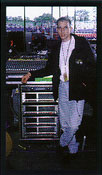 |
||||||||||||||||||||||||||||||||||||||||||||||||||||||||||||||||
| Jeff Paolini Tour Recording Engineer/Stage Manager
PS: Why are the shows being recorded? Jeff: Originally it was just because the band has always archived everything and now there is a rumour of a live release down the road. We create a 2-track DAT every night that Randy or Burton listens to and if there is something that they like, I mark it. I'll be sitting down |
||||||||||||||||||||||||||||||||||||||||||||||||||||||||||||||||
|
Jeff Paolini, Recording Engineer/Stage Manager |
||||||||||||||||||||||||||||||||||||||||||||||||||||||||||||||||
|
with Burton at the end (of the tour) to run through all the tapes. PS: What gear are you using? Jeff: There is a three-way balanced split to a Mackie 32.8 straight to four Alesis ADATs for 32 tracks. PS: No dynamics processing? Jeff: We are trying to keep everything as simple as possible and we will let the studio engineers do their thing. |
||||||||||||||||||||||||||||||||||||||||||||||||||||||||||||||||
|
|
||||||||||||||||||||||||||||||||||||||||||||||||||||||||||||||||
|
|
||||||||||||||||||||||||||||||||||||||||||||||||||||||||||||||||